Rank Species | Genus Trachycarpus Higher classification Trachycarpus | |
 | ||
Similar Trachycarpus, Palm trees, Chamaerops, Trachycarpus fortunei, Washingtonia | ||
Trachycarpus fortunei chusan palm at big plant nursery in west sussex uk
Trachycarpus fortunei, the Chinese windmill palm, windmill palm or Chusan palm, is a palm native to central China (Hubei southwards), southern Japan (Kyushu), south to northern Burma and northern India, growing at altitudes of 100–2,400 m (328–7,874 ft). It is a fan palm, placed in the family Arecaceae, subfamily Coryphoideae, tribe Trachycarpeae.
Contents
- Trachycarpus fortunei chusan palm at big plant nursery in west sussex uk
- Growing palm trees from seeds sowing windmill plam tree seeds trachycarpus fortunei
- Description
- Distribution
- Uses
- Cultivation
- Nomenclature
- References
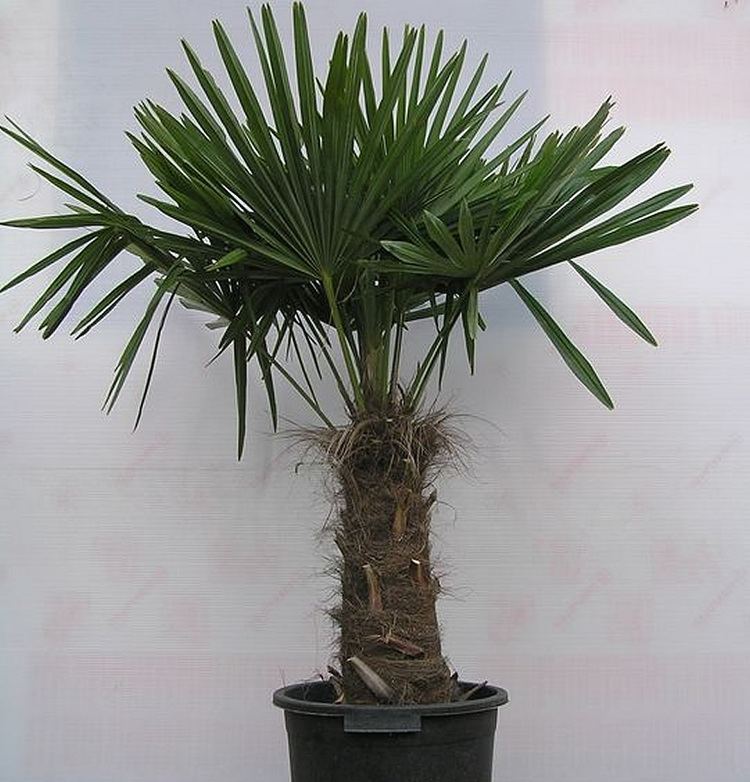
Growing palm trees from seeds sowing windmill plam tree seeds trachycarpus fortunei
Description

Trachycarpus fortunei grows to 12–20 m (40–70 ft) tall on a single stem the diameter of which is up to 15–30 centimetres (6–12 in). The trunk is very rough with the persistent leaf bases clasping the stem as layers of coarse fibrous material. It is a fan palm with the leaves with the long petiole bare except for two rows of small spines, terminating in a rounded fan of numerous leaflets; each leaf is 140–190 centimetres (55–75 in) long, with the petiole 60–100 centimetres (24–39 in) long, and the leaflets up to 90 centimetres (35 in) long. It is a somewhat variable plant, especially as regards its general appearance and some specimens are to be seen with leaf segments having straight and others having drooping tips.

The flowers are yellow (male) and greenish (female), about 2–4 millimetres (79⁄1000–157⁄1000 in) across, borne in large branched panicles up to 1 metre (3 ft 3 in) long in spring; it is dioecious, with male and female flowers produced on separate trees. The fruit is a yellow to blue-black, reniform (kidney-shaped) drupe 10–12 millimetres (39⁄100–47⁄100 in) long, ripening in mid autumn.
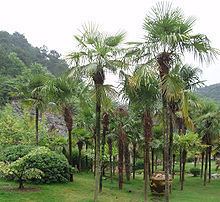
Occasionally a male plant of T. fortunei, besides the usual spadices, produces a few other spadices carrying really hermaphroditic flowers. Completely fertile, these are almost exactly like the male flowers, but are a little larger and with the carpels well evolute, the latter about as long as the filaments, furnished with a ring of silvery hairs all round.
Distribution
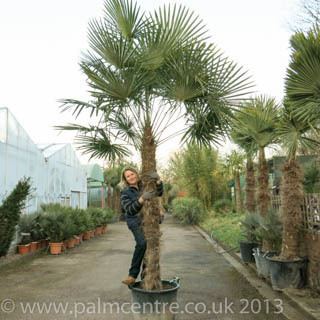
Windmill palm is one of the hardiest palms. It tolerates cool, moist summers as well as cold winters, as it grows at much higher altitudes than other species, up to 2,400 m (7,874 ft) in the mountains of southern China. It is not the northernmost naturally occurring palm in the world, as European fan palm (Chamaerops humilis) grows further north in the Mediterranean.
Uses
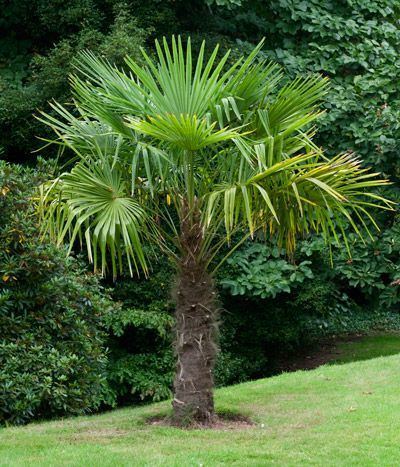
Trachycarpus fortunei has been cultivated in China and Japan for thousands of years, for its coarse but very strong leaf sheath fibre, used for making rope, sacks, and other coarse cloth where great strength is important. The extent of this cultivation means that the exact natural range of the species is uncertain.
Cultivation
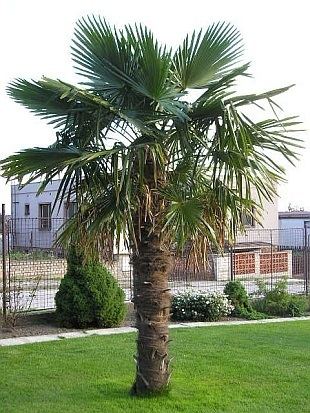
Trachycarpus fortunei is cultivated as a trunking palm in gardens and parks throughout the world in warm temperate and subtropical climates. Its tolerance of cool summers and cold winters makes it highly valued by palm enthusiasts, landscape designers and gardeners. It can be grown successfully in such cool and damp but relatively winter-mild locales as Scotland, Southern New England, Long Island, and British Columbia Canada, as well as in warm temperate climates in parts of the United States, Europe (predominantly UK, France, Belgium, The Netherlands and Germany), New Zealand, and Asia. It does not grow well in very hot climates.
Commonly lower tolerance limits of −15 to −20 °C (5 to −4 °F) are cited for mature plants. Young plants are less hardy, and can be damaged by only 8 °C (46 °F). This plant has gained the Royal Horticultural Society's Award of Garden Merit.
The cultivar group Trachycarpus fortunei 'Wagnerianus' is a small-leafed semi-dwarf variant of the species selected in cultivation in China and Japan. It differs in rarely growing to more than 5 m (16 ft) tall, with leaflets less than 45 cm (18 in) long; the short stature and small leaves give it greater tolerance of wind exposure. It has often been treated as a separate species T. wagnerianus in popular works, but is now included within T. fortunei.
Individuals belonging to a similar species, Trachycarpus takil, have survived a very harsh winter spell in Plovdiv.
Nomenclature
The species was brought from Japan (Dejima) to Europe by the German physician Philipp Franz von Siebold in 1830. The common name refers to Chusan Island (now Zhoushan Island), where Robert Fortune first saw cultivated specimens of the species. In 1849, Fortune smuggled Windmill palm plants from China to the Kew Horticultural Gardens and the Royal garden of Prince Albert of England. The Windmill Palm was later named Trachycarpus fortunei, after him. It was first described by Carl Friedrich Philipp von Martius in 1850 in his Historia Naturalis Palmarum but under the illegitimate name of "Chamaerops excelsa".
The names Chamaerops excelsus and Trachycarpus excelsus have occasionally been misapplied to Trachycarpus fortunei; this is correctly a synonym of Rhapis excelsa, with the confusion arising due to a misunderstanding of Japanese vernacular names.
